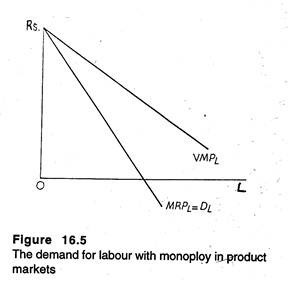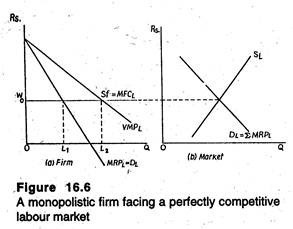In this article we will discuss about the Demand for Labour under Monopoly in Product Markets and Pure Competition in Factor Markets.
The only modification that we have to make is to change the assumption that the firm under consideration is a firm with monopoly power in product markets, rather than a firm selling its product in pure competition. This means that the product price will fall as the firm sells additional units of its product.
The following table illustrates the point. The only difference with our previous analysis is that product price (column 4) falls as the firm produces and sells more output. VMPL and MRPL are calculated in the same manner as before.
VMPL is simply the valuation of the labour’s marginal physical product, so VMPL = MPPL-P (column 3 times column 4). MRPL is found by multiplying the MPPL by marginal revenue. MRPL is shown in column 7. Note that now VMPL> MRPL. This is because under monopoly, price is greater than marginal revenue.
ADVERTISEMENTS:
In Figure 16.5, the MRPL curve is again the firm’s demand curve for labour. This firm, like the previous firm, will employ labour until MRPL = MFCL. Although the firm is selling its product in a monopolistic product market, it is purchasing labour in a competitive labour market.
The firm is thus faced with the situation diagrammed in Figure 16.6. The market demand curve is, as before, found by summing the MRPL curves for all firms purchasing this type of labour.
The market supply (Si) depends on individual desires of workers. The market-determined wage is OW0. This firm can purchase as much labour as it desires at OW0; so the supply curve facing it, Sƒ ,is perfectly elastic at OW0. Since Sƒ is perfectly elastic, MFCL is also perfectly elastic.
ADVERTISEMENTS:
The firm maximizes profits where MFCL= MRPL, so the firm hires OL1 units of labour. Figure 16.6 shows that the monopolist pays OW0, the market wage. The fact that MRP < VMP does not mean the monopolist exploits labour by paying too little — the monopolist has to pay the market wage just like any other employer in this market.
Instead, it means that the monopolist employs fewer labourers than similar competitive firms would employ. Recall that the monopolist restricts output to raise price.
Likewise, in the factor market the monopolist restricts inputs in order to restrict output. If this were a competitive firm rather than a monopolist, it would want to be on the VMP curve (which would then also be the MRPL curve) and employ OL2 workers.

